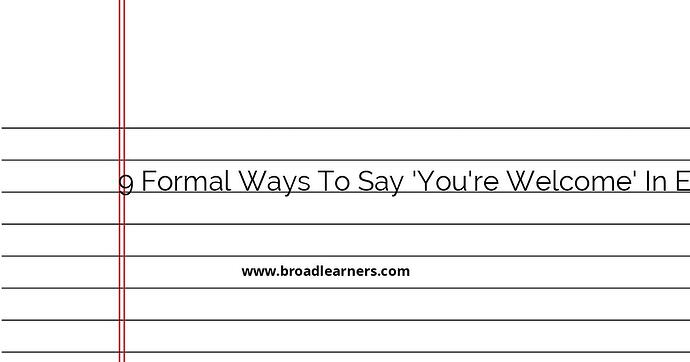When communicating in a professional environment, especially through emails, it's important to respond with formality and courtesy. Saying 'You're welcome' formally conveys respect and professionalism. Below are nine formal ways to express 'You're welcome' in emails:
- My pleasure.
- You're most welcome.
- It was my honor.
- I am pleased to have been of assistance.
- Happy to help.
- It was no bother at all.
- Glad to be of help.
- I am here to serve.
- I am at your service.
Now, let's delve into details for each formal expression:
1. My pleasure
Using 'My pleasure' signifies that you have found joy in helping the recipient. It expresses your willingness and enthusiasm in providing assistance without expecting anything in return.
Example:
Dear Paul,
Thank you for acknowledging my assistance with the report. It was my pleasure.
Warm regards,
Jessica
2. You're most welcome
By saying 'You're most welcome,' you are emphasizing the friendliness and sincerity behind your gesture. This phrase is suitable for expressing genuine hospitality and politeness.
Example:
Hi Lisa,
You're most welcome. I'm glad I could assist you with your query.
Best wishes,
Andrew
3. It was my honor
This expression conveys a deep sense of respect and privilege in helping someone. It adds a layer of formal gratitude, suggesting that the act of assistance was significant and cherished.
Example:
Dear Mr. Smith,
It was my honor to assist with your business proposal. Please let me know if further help is needed.
Sincerely,
Emily
4. I am pleased to have been of assistance
This phrase communicates satisfaction in being able to provide help. It highlights professionalism and reflects a courteous disposition.
Example:
Dear Anna,
I am pleased to have been of assistance in your recent project. Feel free to reach out for any future support.
Kind regards,
Michael
5. Happy to help
'Happy to help' is a concise expression of pleasure in being able to assist. It's professional while maintaining a friendly tone, and it indicates willingness to offer help again.
Example:
Hi James,
Happy to help with the report revisions. Let me know if you require further adjustments.
Best regards,
Katherine
6. It was no bother at all
This expression reassures the recipient that supporting them did not burden you. It shows your eager readiness to help without any implications of inconvenience.
Example:
Dear Sarah,
It was no bother at all to coordinate the meeting times. I am always here for scheduling support if needed.
Kind regards,
Daniel
7. Glad to be of help
This phrase is straightforward and expresses your satisfaction in assisting. It's a humble acknowledgment of your readiness to aid without any form of pretense.
Example:
Hi Olivia,
I'm glad to be of help with your concerns. Always feel free to reach out for anything else you may need.
Warm regards,
Emma
8. I am here to serve
Indicating 'I am here to serve' conveys dedication and a high level of professionalism. It's a formal way to highlight your commitment to the recipient's needs.
Example:
Dear Mr. Johnson,
I am here to serve and always ready to help you execute your strategic plans effectively.
Sincerely,
Christopher
9. I am at your service
This phrase communicates availability and readiness to assist whenever required, portraying a professional yet considerate approach to addressing tasks and queries.
Example:
Hey Maria,
I am at your service for any follow-up queries or further assistance with the project deliverables.
Best regards,
Lucas
These nine formal ways to say 'You're welcome' in emails are instrumental in enhancing your email etiquette while ensuring your professionalism is effectively communicated.
Did I miss anything? Respond below
